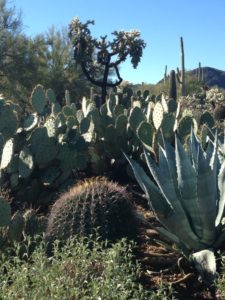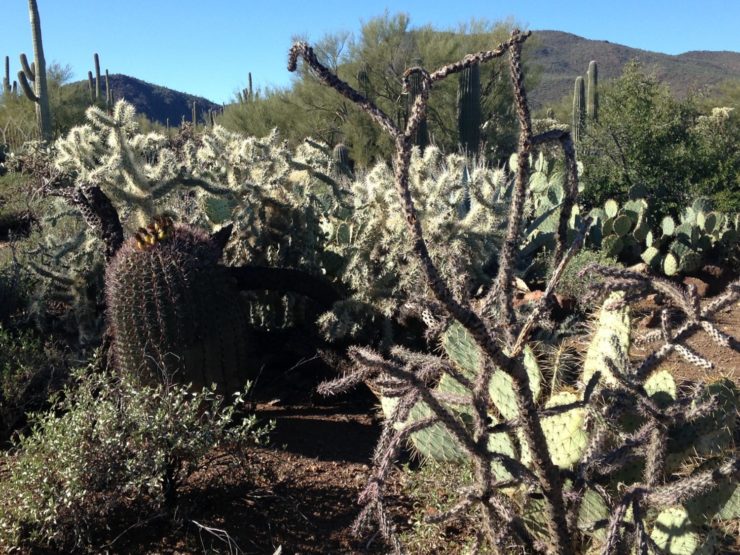Editor’s note: This is another in our Shop Class series. The goal is to break down the work that goes into creating stories, and offer prompts, suggestions or exercises to help you practice the craft that becomes art.
The assignment is to observe and collect concrete, sensory details — details from the bottom of the ladder of abstraction, details that evoke memory and emotion, details that help readers see in a new way – while roaming the grounds of the eclectic ranch in Tucson, Arizona. Twelve of us have gathered for a weekend writing workshop. Late the first morning we are sent into the surrounding desert with this direction: Look beyond what you see. Try to describe things so readers can see them in new ways.
I head out with my notebook and my anxiety.
The first cactus is the green of a lima bean. It has hooked spines with the hardness of a fingernail. The second cactus is the green of a… of a… pale olive. Its spines are thin and sharp as a pin. I don’t describe the green of the third cactus. Why bother? The fourth cactus is the green of a watermelon rind. Its thick spines are black.
As I look across the desert, I see dark greens, pale greens, dusty greens. I am struck by the variety of forms and of color in the cacti that sprawl as far as I can see. But when it's time to return to the workshop group for a critique, I wonder: How can I make the others see these shades of green? They are different yet all the same. Green. Green. Green. What I’m doing so far isn’t working. I can’t even see these various shades myself.
The fifth cactus: paddles of pale green. That’s just avoiding the problem. Then, I come to a tree. Its trunk is the green of forest shade. That’s better. Its branches and stems are the yellow-green of a new leaf.
No, not the green of a new leaf. This will not do. I can’t bring my classmates back a description comparing one part of a tree to another part. I can’t paint a picture of a plant, like a barrel cactus, by comparing it to another plant, such as a lima bean. For a description to work, I realize, the two things being compared have to be different or the comparison offers no depth.
The power of an analogy lies in the distance between the two things being compared. This lets people who don’t think often about plants, for example, feel comfortable or engaged or delighted reading a piece about cacti. Or at least helps them visualize different cacti (they are so different!) because their personal colors, while all green, are different.
Many of the writers at the workshop are biomedical journalists, so I wonder if connecting vastly different ideas sends the electrical impulse of connecting synapses farther through your brain. I love that feeling of my brain lighting up with a new discovery. I suspect that readers do, too.
 I’ve got to stop these plant-to-plant comparisons. But how?
I’ve got to stop these plant-to-plant comparisons. But how?
I crouch between the cacti, my notebook propped on my knee. “What is green besides plants?” I write.
I think for a long time, the sun on my back and the breeze ruffling my hair, before I come up with cars. Some cars are green. But that’s not really helpful. I need to be more specific. British racing green. The pale green of a second-generation Volkswagen Beetle. This is more like it.
Clothing is green, but again, that’s not specific enough. What kind of clothing would be a color everyone knows? Military uniforms are a specific shade of green. And football jerseys: Jets, Eagles, Packers, Seahawks. I could describe an entire Cactus Conference that way, if cacti were any of these colors.
I think of water. This has potential. Water comes in so many forms and so many shades of green, from scummy ponds to sea foam, from the Caribbean shore to the depths of the North Atlantic. Bodies of water are different from the desert, a place defined by its lack of water. Yet both are, in their own way, green.
But what about the green of forest shade? That felt right. How about using, not things, but feelings or experiences to describe shades of green? The green of a spring breeze. The green of a jealous lover.
Deciding which of these descriptions to apply would depend on the scene I was setting. Expensive sod could be the color of money. The fairway of an abandoned golf course could be the faded green of lost dreams.
I stand up and start walking back to the ranch house. But as I turn the corner, an ankle-high plant catches my eye. Its leaves are fleshy swords of ocean green with white, serrated shark’s tooth edges.
I shouldn’t describe a sixth cactus. I’ve already done too many descriptions, and besides, it’s time to head back. But I’ve learned so much since that fifth cactus, crouching on the desert sand and squinting at shades of green. So I do.
The assignment is to observe and collect concrete, sensory details — details from the bottom of the ladder of abstraction, details that evoke memory and emotion, details that help readers see in a new way – while roaming the grounds of the eclectic ranch in Tucson, Arizona. Twelve of us have gathered for a weekend writing workshop. Late the first morning we are sent into the surrounding desert with this direction: Look beyond what you see. Try to describe things so readers can see them in new ways.
I head out with my notebook and my anxiety.
The first cactus is the green of a lima bean. It has hooked spines with the hardness of a fingernail. The second cactus is the green of a… of a… pale olive. Its spines are thin and sharp as a pin. I don’t describe the green of the third cactus. Why bother? The fourth cactus is the green of a watermelon rind. Its thick spines are black.
As I look across the desert, I see dark greens, pale greens, dusty greens. I am struck by the variety of forms and of color in the cacti that sprawl as far as I can see. But when it's time to return to the workshop group for a critique, I wonder: How can I make the others see these shades of green? They are different yet all the same. Green. Green. Green. What I’m doing so far isn’t working. I can’t even see these various shades myself.
The fifth cactus: paddles of pale green. That’s just avoiding the problem. Then, I come to a tree. Its trunk is the green of forest shade. That’s better. Its branches and stems are the yellow-green of a new leaf.
No, not the green of a new leaf. This will not do. I can’t bring my classmates back a description comparing one part of a tree to another part. I can’t paint a picture of a plant, like a barrel cactus, by comparing it to another plant, such as a lima bean. For a description to work, I realize, the two things being compared have to be different or the comparison offers no depth.
The power of an analogy lies in the distance between the two things being compared. This lets people who don’t think often about plants, for example, feel comfortable or engaged or delighted reading a piece about cacti. Or at least helps them visualize different cacti (they are so different!) because their personal colors, while all green, are different.
Many of the writers at the workshop are biomedical journalists, so I wonder if connecting vastly different ideas sends the electrical impulse of connecting synapses farther through your brain. I love that feeling of my brain lighting up with a new discovery. I suspect that readers do, too.
 I’ve got to stop these plant-to-plant comparisons. But how?
I’ve got to stop these plant-to-plant comparisons. But how?I crouch between the cacti, my notebook propped on my knee. “What is green besides plants?” I write.
I think for a long time, the sun on my back and the breeze ruffling my hair, before I come up with cars. Some cars are green. But that’s not really helpful. I need to be more specific. British racing green. The pale green of a second-generation Volkswagen Beetle. This is more like it.
Clothing is green, but again, that’s not specific enough. What kind of clothing would be a color everyone knows? Military uniforms are a specific shade of green. And football jerseys: Jets, Eagles, Packers, Seahawks. I could describe an entire Cactus Conference that way, if cacti were any of these colors.
I think of water. This has potential. Water comes in so many forms and so many shades of green, from scummy ponds to sea foam, from the Caribbean shore to the depths of the North Atlantic. Bodies of water are different from the desert, a place defined by its lack of water. Yet both are, in their own way, green.
But what about the green of forest shade? That felt right. How about using, not things, but feelings or experiences to describe shades of green? The green of a spring breeze. The green of a jealous lover.
Deciding which of these descriptions to apply would depend on the scene I was setting. Expensive sod could be the color of money. The fairway of an abandoned golf course could be the faded green of lost dreams.
I stand up and start walking back to the ranch house. But as I turn the corner, an ankle-high plant catches my eye. Its leaves are fleshy swords of ocean green with white, serrated shark’s tooth edges.
I shouldn’t describe a sixth cactus. I’ve already done too many descriptions, and besides, it’s time to head back. But I’ve learned so much since that fifth cactus, crouching on the desert sand and squinting at shades of green. So I do.



